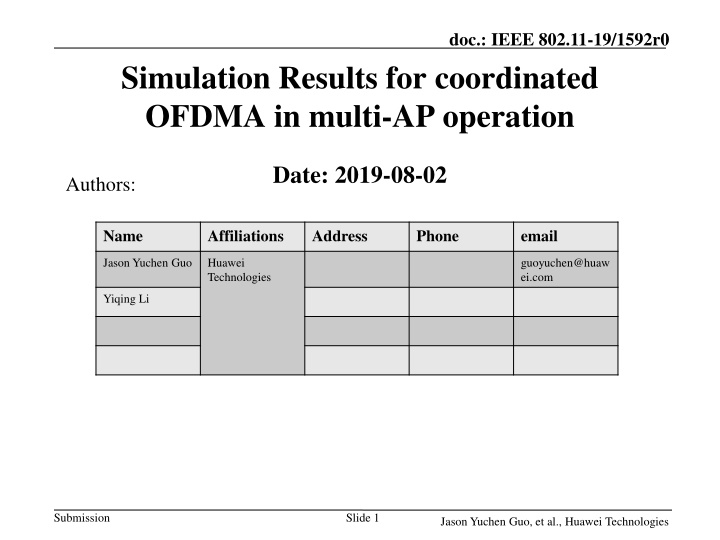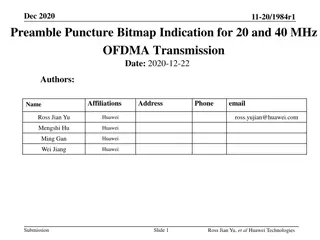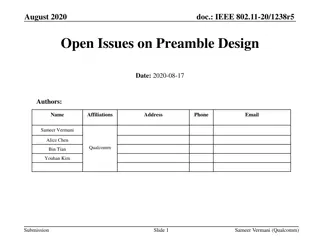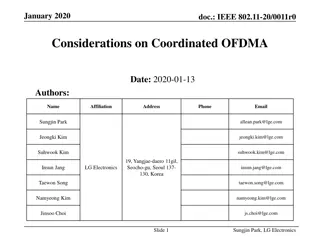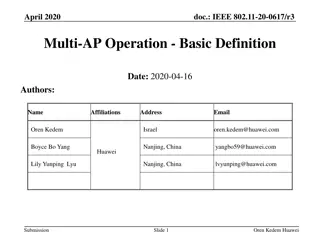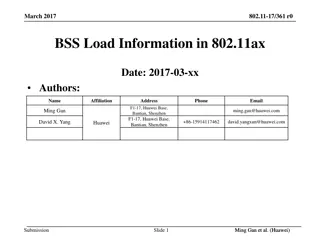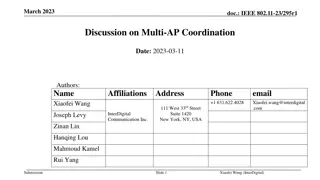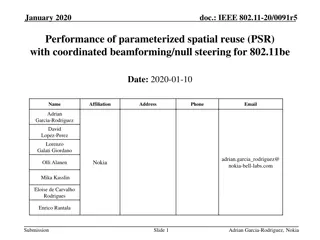Simulation Results for Coordinated OFDMA in Multi-AP Operation
Multi-AP operation, specifically Coordinated OFDMA, is evaluated through system-level simulation results in a two-BSS scenario. The performance metrics include burst throughput and delay in a burst traffic model. Transmission procedure involves two APs sharing 160MHz bandwidth. The study aims to showcase the potential benefits of Coordinated OFDMA in enhancing network performance.
Download Presentation

Please find below an Image/Link to download the presentation.
The content on the website is provided AS IS for your information and personal use only. It may not be sold, licensed, or shared on other websites without obtaining consent from the author.If you encounter any issues during the download, it is possible that the publisher has removed the file from their server.
You are allowed to download the files provided on this website for personal or commercial use, subject to the condition that they are used lawfully. All files are the property of their respective owners.
The content on the website is provided AS IS for your information and personal use only. It may not be sold, licensed, or shared on other websites without obtaining consent from the author.
E N D
Presentation Transcript
doc.: IEEE 802.11-19/1592r0 Simulation Results for coordinated OFDMA in multi-AP operation Date: 2019-08-02 Authors: Name Affiliations Address Phone email Jason Yuchen Guo Huawei Technologies guoyuchen@huaw ei.com Yiqing Li Submission Slide 1 Jason Yuchen Guo, et al., Huawei Technologies
doc.: IEEE 802.11-19/1592r0 Introduction Multi-AP operation is considered as a major candidate feature for 802.11be [1]. There are four modes of Multi-AP operation that are under discussion in EHT SG and TGbe: Coordinated BF [2][3][5][7][8] Coordinated OFDMA [2][3][8] Coordinated SR [4][9] Joint transmission [2][3][5][6][10][11] Among the four modes, Coordinated OFDMA has been proposed without simulation results, while other three modes are demonstrated by simulation results to show performance gain in different scenarios [4-11]. In this contribution, we evaluate the performance of coordinated OFDMA by system level simulation results. Submission Slide 2 Jason Yuchen Guo, et al., Huawei Technologies
doc.: IEEE 802.11-19/1592r0 Simulation Scenario We consider a two-BSS scenario (e.g., home environment), where two APs are 20 meters away from each other. In each BSS, there is one STA randomly placed in the coverage range of each AP. Total bandwidth: 160MHz Packet size: 1500bytes A-MPDU: 64 (Maximum) MCS: 9 Nsts: 1 STA2 AP2 AP1 STA1 Submission Slide 3 Jason Yuchen Guo, et al., Huawei Technologies
doc.: IEEE 802.11-19/1592r0 Simulation Scenario Traffic Model: Burst traffic Packets arrive in the form of bursts, for each burst, there are 400 packets Packets are assumed to arrive at the beginning of each burst, all arrive at the same time The traffic data rate affects the burst interval: the higher traffic data rate, the shorter burst interval Burst interval Burst 1 Burst 2 Burst 3 Burst 4 Performance Metric: Burst throughput Burst throughput = Number of bits in a burst / (T1 T0) T0 is the time that the first bit of the burst comes into the buffer T1 is the time that the whole burst is transmitted successfully We simulate 150 bursts, and calculate the average burst throughput as the performance metric Delay (T1 T0) is also used as a performance metric Submission Slide 4 Jason Yuchen Guo, et al., Huawei Technologies
doc.: IEEE 802.11-19/1592r0 Transmission Procedure Coordinated OFDMA Two APs share the whole 160MHz bandwidth Two APs stay on the same primary channel, and contend to access the channel using EDCA. When the backoff counter reaches zero, each AP will do the following With probability p, the AP will send a slave trigger frame to the other AP to initiate co-OFDMA transmission, where each AP can use 80MHz to do the data transmission With probability 1-p, the AP will use the whole 160MHz channel to do the data transmission Baseline Two APs will use two different 80MHz channels for data transmissions The two 80MHz channels are non-overlapping with each other Coordinated OFDMA Baseline Dynamic bandwidth Dedicated channel No collision Pros Collision may happen Slave TF overhead Maximum bandwidth is limited Cons Submission Slide 5 Jason Yuchen Guo, et al., Huawei Technologies
doc.: IEEE 802.11-19/1592r0 Simulation Results When traffic data rate is low, co-OFDMA has a wide dynamic range of burst throughput, depending on the probability of using co-OFDMA When co-OFDMA is not used, each AP can occupy the whole 160MHz, making it faster to finish the transmission of a burst When traffic data rate is high, using baseline is slightly better, since the packet loss rate is lower, but there s not much different between all the schemes In conclusion, using co-OFDMA with lower probability is better 800 50 baseline co_OFDMA_P=0 co_OFDMA_P=0.5 co_OFDMA_P=1 baseline co_OFDMA_P=0 co_OFDMA_P=0.5 co_OFDMA_P=1 45 700 40 600 35 Burst Throughput / Mbps Packet Loss Rate / % 500 30 400 25 20 300 15 200 10 100 5 0 0 0.6 6 60 120 240 480 960 1920 0.6 6 60 120 240 480 960 1920 Traffic Data Rate / Mbps Traffic Data Rate / Mbps Submission Slide 6 Jason Yuchen Guo, et al., Huawei Technologies
doc.: IEEE 802.11-19/1592r0 Simulation Results Delay is a direct transform of burst throughput Under low traffic data rate, using co-OFDMA with lower probability can provide better delay performance, because using wider bandwidth can reduce the delay significantly; Under high traffic data rate, baseline is slightly better, but there are not much difference among all the schemes. 300 15 14 250 13 baseline co_OFDMA_P=0 co_OFDMA_P=0.5 co_OFDMA_P=1 200 12 Delay / ms Delay / ms 11 150 10 baseline co_OFDMA_P=0 co_OFDMA_P=0.5 co_OFDMA_P=1 100 9 8 50 7 0 6 0 200 400 600 800 1000 1200 1400 1600 1800 2000 0 50 100 150 200 250 Traffic Data Rate / Mbps Traffic Data Rate / Mbps Submission Slide 7 Jason Yuchen Guo, et al., Huawei Technologies
doc.: IEEE 802.11-19/1592r0 Conclusion We evaluate the performance of co-OFDMA by system level simulation results in home environment. The results show that using co-OFDMA with higher probability does not provide much performance gain regarding burst throughput and latency, conversely, using co-OFDMA with lower probability is better. It is encouraged for people to do more simulation on co-OFDMA to show the performance gain. Submission Slide 8 Jason Yuchen Guo, et al., Huawei Technologies
2018 doc.: IEEE 802.11-19/1592r0 Reference [1] 11-18-1231-06-0eht-eht-draft-proposed-par [2] 11-18-1576-01-0eht-considerations-on-ap-coordination [3] 11-18-1509-00-0eht-features-for-multi-ap-coordination [4] 11-19-801-00-0eht-ap-coordination-in-eht [5] 11-18-1510-01-0eht-ap-coordinated-beamforming-for-eht [6] 11-19-0800-00-00be-joint-processing-mu-mimo-update [7] 11-19-0638-00-00be-nulling-and-coordinated-beamforming [8] 11-18-1155-01-0eht-Multi-AP Enhancement and Multi-Band Operations [9] 11-19-0071-00-0eht-Coordinated Multi-AP Transmission for EHT [10] 11-19-0763-00-00be-measurements-for-distributed-mu-mimo [11] 11-19-0779-01-00be-performance-investigation-on-multi-ap-transmission Submission Slide 9 Jason Yuchen Guo, et al., Huawei Technologies
